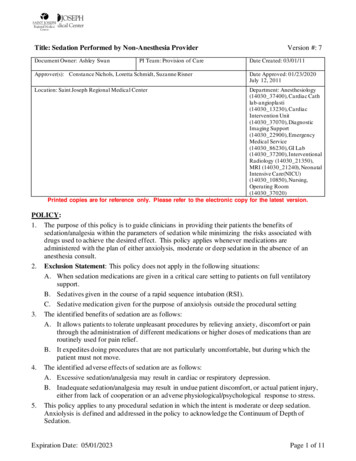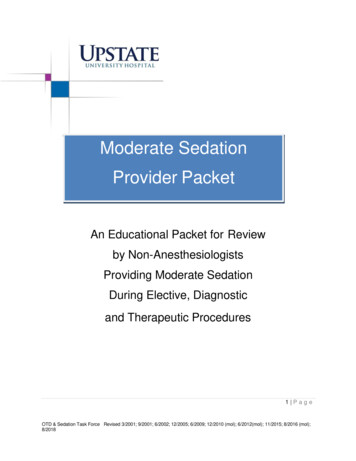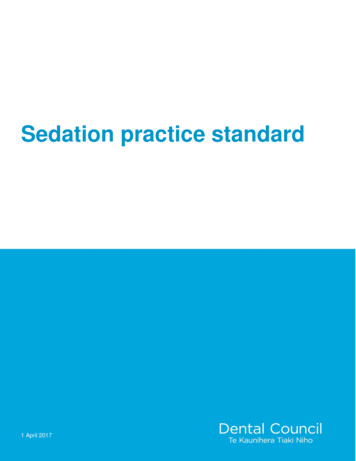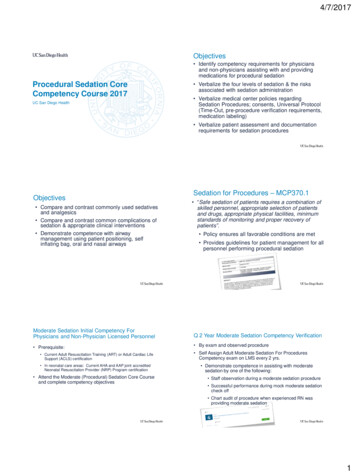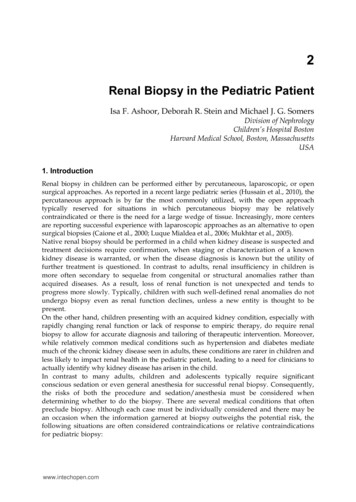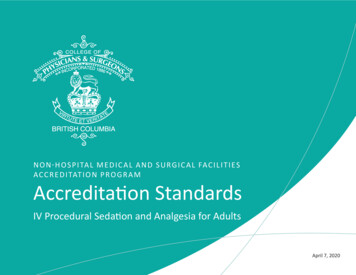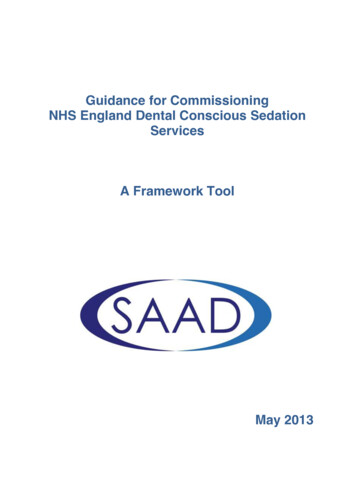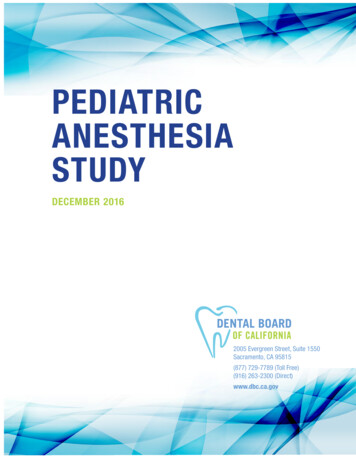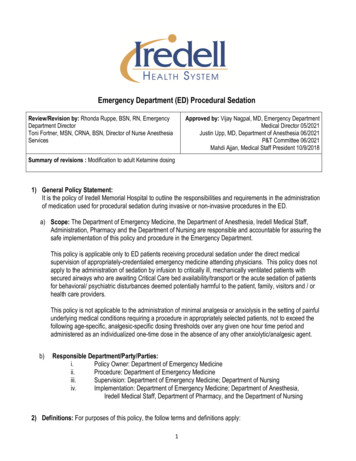
Transcription
Emergency Department (ED) Procedural SedationReview/Revision by: Rhonda Ruppe, BSN, RN, EmergencyDepartment DirectorToni Fortner, MSN, CRNA, BSN, Director of Nurse AnesthesiaServicesApproved by: Vijay Nagpal, MD, Emergency DepartmentMedical Director 05/2021Justin Upp, MD, Department of Anesthesia 06/2021P&T Committee 06/2021Mahdi Ajjan, Medical Staff President 10/9/2018Summary of revisions : Modification to adult Ketamine dosing1) General Policy Statement:It is the policy of Iredell Memorial Hospital to outline the responsibilities and requirements in the administrationof medication used for procedural sedation during invasive or non-invasive procedures in the ED.a) Scope: The Department of Emergency Medicine, the Department of Anesthesia, Iredell Medical Staff,Administration, Pharmacy and the Department of Nursing are responsible and accountable for assuring thesafe implementation of this policy and procedure in the Emergency Department.This policy is applicable only to ED patients receiving procedural sedation under the direct medicalsupervision of appropriately-credentialed emergency medicine attending physicians. This policy does notapply to the administration of sedation by infusion to critically ill, mechanically ventilated patients withsecured airways who are awaiting Critical Care bed availability/transport or the acute sedation of patientsfor behavioral/ psychiatric disturbances deemed potentially harmful to the patient, family, visitors and / orhealth care providers.This policy is not applicable to the administration of minimal analgesia or anxiolysis in the setting of painfulunderlying medical conditions requiring a procedure in appropriately selected patients, not to exceed thefollowing age-specific, analgesic-specific dosing thresholds over any given one hour time period andadministered as an individualized one-time dose in the absence of any other anxiolytic/analgesic agent.b)Responsible Department/Party/Parties:i.Policy Owner: Department of Emergency Medicineii.Procedure: Department of Emergency Medicineiii.Supervision: Department of Emergency Medicine; Department of Nursingiv.Implementation: Department of Emergency Medicine; Department of Anesthesia,Iredell Medical Staff, Department of Pharmacy, and the Department of Nursing2) Definitions: For purposes of this policy, the follow terms and definitions apply:1
a) Procedural sedation and Analgesia: Procedural sedation and analgesia refers to the technique ofadministering sedatives or dissociative agents with or without analgesics to induce an altered state ofconsciousness that allows the patient to tolerate painful or unpleasant procedures while preservingcardiorespiratory function. The intent of the sedation, not necessarily the agent itself, determines whethermedication is being delivered to relieve anxiety (anxiolysis) or to facilitate a specific procedure as withprocedural sedation.b) Minimal sedation: Minimal sedation describes a patient with a near-baseline level of alertness, apharmacologically induced state during which patients respond normally to verbal commands. Althoughcognitive function and coordination might be impaired, ventilator and cardiovascular functions areunaffected. In the ED, minimal sedation is commonly administered to facilitate minor procedures.c) Moderate sedation: Moderate sedation is a pharmacologically induced depression of consciousnessduring which patients respond purposeful to verbal commands, either alone or accompanied by light tactilestimulation. No interventions are required to maintain a patent airway, and spontaneous ventilation isadequate. Cardiovascular function is usually maintained. Moderate sedation patients often exhibit eyelidptosis, slurred speech, and delayed or altered responses to verbal stimuli. Event amnesia will frequentlyoccur under moderate sedation levels. In the ED, moderate sedation is commonly achieved withbenzodiazepine, often in conjunction with an opioid such as fentanyl. Moderate sedation must only beadministered under the direct medical supervision and continuous physical presence of anappropriately credentialed licensed independent practitioner.d) Dissociative sedation: Dissociative sedation is a trance-like cataleptic state characterized by profoundanalgesia and amnesia, with retention of protective airway reflexes and spontaneous breathing. In theED, ketamine is commonly administered to evoke dissociative levels of sedation. Dissociative state canfacilitate moderate to severely painful procedures, as well as procedures requiring immobilization inuncooperative patients. Dissociative sedation must only be administered under the direct medicalsupervision and continuous physical presence of an appropriately credentialed licensedindependent practitioner.e) Deep sedation: Deep sedation is a pharmacologically induced depression of consciousness during whichpatients cannot be easily aroused or respond purposefully after repeated or painful stimulation. The abilityto independently maintain ventilator function may be impaired. Patients may require assistance inmaintaining a patent airway and spontaneous ventilation may be inadequate. Cardiovascular function isusually maintained. Monitoring for deep sedation encounters should emphasize the potential for reductionin ventilation and cardiovascular complications, including changes to pulse rate, heart rhythm, and bloodpressure. Deep sedation is commonly achieved with short-acting sedative agents such as propofol,etomidate, or a benzodiazepine. For painful procedures, an opioid such as fentanyl or morphine sulfatemay be used in concert with the sedative. Many recent studies have described the use of ketamineadministered with propofol to evoke deep sedation levels during painful ED procedures. Deep sedationmust only be administered under the direct medical supervision and continuous physical presenceof an appropriately credentialed licensed independent practitioner.f) General anesthesia: General anesthesia describes a depth of sedation characterized byunresponsiveness to all stimuli and the absence of airway protective reflexes, a pharmacologicallyinduced loss of consciousness during which patients are not arousable, even by painful stimulation.The ability to independently maintain ventilatory function is often impaired. Patients often requireassistance in maintaining a patent airway, and positive-pressure ventilation may be required becauseof depressed spontaneous ventilation or drug-induced depression of neuromuscular function.Cardiovascular function may be impaired.2
g) Immediately available – Physically present in the specific procedural moderate sedation area, notengaged in uninterruptible tasks, and capable of rapidly responding to urgent/emergent patient careneeds.Single Agent Minimal ANALGESIA Hourly Dosing Thresholds:Analgesic AgentAge 16 years@Age 16-70Age 70Fentanyl 2mcg/kg IV/IM 2 mcg/kg IV/IM 1.5 mcg/kg IV/IMMorphine 0.2 mg /kg IM; 0.15 mg/kg IV 0.2 mg/kg IV/IM 0.15 mg/kg IV/IMHydromorphone 0.02 mg/kg IV/ IM 0.02 mg/kg IV/ IM 0.15 mg/kg IV/ IMNOTE: Maximal IV/IM pediatric doses must not exceed minimal analgesic dose for ages 16-70Single Agent Minimal ANXIOLYSIS Hourly Dosing Thresholds:Anxiolytic Agent@Age 16 yearsAge 16-70Age 70Midazolam 0.2mg/kg IM; 0.1mg/kg IV 5 mg IV/IM 2 mg IV/IMDiazepam 0.2 mg /kg IV; 5 mg IV 2 mg IVLorazepam 0.1 mg/kg IV 2 mg IV 1 mg IVNOTE: Maximal IV/IM pediatric doses must not exceed minimal sedation dose for ages 16-70Table 1: Levels of on)Deep ormal response to Purposeful responseverbal stimulation to verbal or tactilestimulationPurposefulresponse followingrepeated or painfulstimulationUnarousable evenwith painfulstimulusAirwayUnaffectedNo interventionrequiredIntervention may be Intervention oftenrequiredrequiredAdequateMay be adequateMinimal tlyinadequate
CardiovascularFunctionUnaffectedUsually maintained4Usually maintained May be impaired
3) Policy Guidelines:A. Personnel Requirements and Qualifications:Licensed Independent Practitioner (LIP) - Any individual permitted by law and credentialed by theorganization to provide care, treatment, and services, without direction or supervision, within the scope ofthe individual’s license and consistent with individually granted clinical privileges. Within the emergencydepartment LIPs are Emergency Department physician members who are American Board of EmergencyMedicine or American Osteopathic Board of Emergency Medicine board certified or board-eligible and, inaddition, have a minimum of 6 months of supervised fellowship experience in procedural sedationadministration within the organization.B. The ED Medical Director is responsible for reviewing if the LIP performing procedures has currentprocedural sedation credentials appropriate for utilizing the sedative medications to beadministered.C. Personnel: The minimum number of health care providers physically attending the patient receivingprocedural sedation shall be two, i.e., the LIP responsible for performing the diagnostic/therapeuticprocedure and a second designated, properly trained monitoring healthcare professional (RegisteredNurse, Advanced Practice Provider, or LIP) who is not otherwise involved in procedure performance. Atleast one attending physician with sedation privileges shall be present.1. The monitoring health care professional participating in the procedural sedation patient is responsiblefor 1) continuously monitoring and documenting at frequent intervals the patient’s clinical andphysiologic status during procedure performance and 2) activating appropriate emergency responseprocesses as clinically indicated. These professionals can include Registered Nurses, AdvancedPractice Providers, and LIPs as defined above. Such individuals should not carry out additionalfunctions during the procedure except for brief, minor, interruptible tasks in patients with stablesedation/analgesia levels and vital signs. Health care professionals charged with monitoring thepatient will be trained in appropriate procedural sedation processes and techniques.2. The LIP is responsible for the overall medical management of the procedural sedation patient as wellas for supervising the patient’s monitoring health care professional. The Center for Medicare Services(CMS) requires that “Rescue” from a deeper level of sedation than intended requires an interventionby a practitioner with expertise in airway management and advanced life support. The qualifiedpractitioner corrects adverse physiologic consequences of the deeper-than-intended level of sedationand returns the patient to the originally intended level of sedation. Such LIP’s will demonstrate current,competency-based training, education, and experience in appropriate procedural sedation patientevaluation/selection processes, safe administration of sedative/analgesic medications, patientclinical/physiologic monitoring during the procedural sedation continuum, and ability to rescue patientswho unavoidably or unintentionally manifest deeper-than-desired levels of sedation (i.e., moderatesedation deep sedation or deep sedation general anesthesia).3.Demonstration of the above qualifications falls into the 5 main areas of competency detailedbelow, all of which must be supported by LIP-specific documentation. Baseline qualifications for allLIP’s (includes all of the following):a.b.A current, unrestricted NCMB/NCNB Certificate of Registration (training or provisionallicenses will not satisfy this criteria)A current, unrestricted DEA Controlled Substances Registration Certificate5
c.d.A current American Heart Association Health Care Professional Card (i.e., BLS, ACLSand/or PALS required) AND/OR Board Certified/Eligible in Emergency Medicine andmaintenance of board certification per ACEP / ABP standardsSatisfactory completion signifying the LIP has read/reviewed the contents of this policy andagrees to abide by its terms, processes, and proceduresD. Capabilities:1. Each procedural sedation site and its respective recovery site (if physically separate from theprocedural sedation site) must have the following minimum equipment present and in workingorder:Cardiac monitor with alarm capabilitiesPulse oximeter with alarm capabilitiesBlood pressure measurement device with alarm capabilitiesSuction capabilities with appropriate devices, attachments, and tubingA high pressure oxygen source capable of delivering a 15 l/min inspiratory flow rate for at least30 minutesf. A self-inflating reservoir bag-valve-mask system capable of both supporting ventilation as welldelivering 90% oxygen concentration at the above flow ratesg. Capnography equipment (required for Deep Sedation)a.b.c.d.e.2. In addition, each procedural sedation clinical area and its respective recovery area (if physicallyseparate from the procedural sedation area) must have the following emergency responsecapabilities immediately available:a. A fully stocked and appropriately maintained emergency resuscitation cart (which containsthe reversal agents naloxone and flumazenil) consistent with current Medical Center CodeBlue Committee recommendationsb. A summary of current, age-appropriate resuscitation algorithms (i.e., ACLS, PALS)c. A summary of age-appropriate doses of naloxone and flumazenilE. Pre-Procedure Processes and Informed Consent:1. In compliance with medical staff rules and regulations, all patients receiving procedural sedationmust receive a pre-procedure medical evaluation under the medical supervision of the LIPfocusing on major organ systems to assess their current overall medical condition and determineif they are suitable procedural sedation candidates.2. While components of this required pre-assessment may be delegated to appropriately licensedhealth care professionals operating within their legal scope of practice, the LIP is ultimatelyresponsible for reviewing and confirming the accuracy of all information so collected. Suchresponsibility must be documented by the LIP’s signature in the pre- assessment area in themedical record.3. The pre-procedure history must include at least:a. Review of pertinent medical records and current hospital course as appropriateb. A brief past medical history and review of systems, with particular emphasis on the airway,respiratory, cardiovascular, and central nervous systems. Special emphasis should be placed6
c.d.e.f.g.h.i.on soliciting a history of/signs and symptoms consistent with a diagnosis of obstructive sleepapnea (OSA) [i.e., BMI 35 kg/cm2, nighttime CPAP use, loud snoring, etc.].Review of current medications, including both pertinent nonprescription and herbal“supplements”.Medication allergies/adverse reactions and their specific clinical manifestationsPrevious responses to sedatives, analgesics, and/or anesthesiaTobacco, alcohol, and/or illicit drug useLast menstrual period and/or pregnancy test results in females of childbearing ageResults of any pertinent diagnostic studies (including resistant organism precautions)Patients requiring emergent procedures in the setting of inadequate fasting periods are atincreased risk for aspiration of gastric contents and must undergo an individualized riskbenefit analysis with regards to proceeding immediately under such conditions versusappropriately delaying the procedure to meet these fasting criteria.F. Fasting Guidelines:NPO status for liquids and solids is not an independent predictor of major complications oraspiration in a pediatric sedation/anesthesia setting.1. For healthy patients undergoing elective sedation/analgesia, other professional societyguidelines outside of emergency medicine recommend:a. 2-hour fasting time for clear liquidsb. 6-hour fasting time for solids2. Applying these guidelines to ED procedural sedation and analgesia may not change the risk ofemesis or aspiration. Even within the strict framework of these guidelines, emergent sedations arean exclusion from fasting requirements, although care must be made for airway protection.3. As a result, guidelines for elective procedures in the operating room (e.g., nothing by mouth,preoperative fasting guidelines) are not directly applicable in the ED. In addition, multiple otherpractice guidelines and systematic reviews do not find evidence to support a specific fasting periodbefore ED procedural sedation. Care, however, must be used in the patient in whom deep sedationmay occur. In essence, specific risk factors for regurgitation and aspiration (bowel obstruction,gastroparesis, poor existing airway reflexes) should be balanced with the type of sedation andurgency of the procedure needing to be performed. Patients requiring emergent procedures in thesetting of inadequate fasting periods may be at increased risk for aspiration of gastric contents andmust undergo an individualized risk- benefit analysis with regards to proceeding immediately undersuch conditions, consulting Anesthesia, or appropriately delaying the procedure to meet fastingcriteria.G. Pre-Procedural Physical Exam:1. The pre-procedure physical examination should follow established Emergency Department Policyand include at least:a.b.c.d.e.Height, weight, and BMIBaseline blood pressure, pulse, respiratory rate, and pulse oximetry measurementsAn evaluation of baseline mental status and level of consciousnessAirway examCardiac and pulmonary exams7
2. Although ED Physicians regularly deal with critically ill patients and strong sedation/anestheticmedications expected in a high acuity setting, sedation on patients at higher risk for complicationsfor non-emergent procedures may be more appropriate for another setting. Consultation withAnesthesiology is available when significant risk factors (such as ASA classification 3) forprocedural sedation complications are identified during the pre-procedure assessment process.H. Informed Consent and Immediate Pre-Procedure Processes and Documentation:1. Following completion of the pre-procedure assessment, the patient or guardian must be informedof the risks, benefits, and alternatives to procedural sedation as a component of the plannedprocedure by a health care professional with current, active procedural sedation credentials. Risksof sedation in non-fasting patients must be specifically and separately discussed and documented.Such informed consent must be appropriately documented in the patient’s permanent medicalrecord prior to initiating procedural sedation administration, and the current institution universalprocedure protocol must be followed in all appropriate patients and documented in the medicalrecord.2. Immediate pre-procedure baseline vital signs [to include blood pressure, pulse, respiratoryrate, pulse oximetry measurement, level of consciousness/mental status, visual analog painscore (adults and older children only), and temperature (infants and younger children only)]and the patient’s airway status must be documented in all patients and determined to beacceptable for proceeding.I. Intra-procedure Processes and Documentation1. With the possible exception of infants/children, it is strongly recommended that adequateintravenous (IV) access be obtained in all patients requiring procedural sedation and that IVadministration of sedatives and analgesics be utilized due to its more rapid and predictableonset of action. All IV sedatives and analgesics so administered must be drawn asepticallyinto separate syringes and labeled with the medication name and concentration. The choiceof procedural sedation agent(s) and dosage(s) administered is the responsibility of the LIPand should be individualized based upon patient-specific factors identified during the preprocedure assessment as well as conditions required for acceptable procedure performance.Table 2: IV SEDATION and reversal medication GUIDELINES FOR ADULTSMedicationInitial IV doseOnset of actionIncremental IV doseKetamine0.5-1 mg/kg3-5 minutes0.5 mg/kg q1 min, up to total of2 mg/kg in first 3 mins. Mayrepeat q5 mins as needed.Morphine0.05-0.1 mg/kg5 minutes2-3 mgFentanyl1-2 mcg/kg3-5 minutes25-50 mcgMidazolam0.05 mg/kg3-5 minutes0.5-1 mg8
Etomidate0.1 - 0.15 mg/kgLess than 1 minuteFlumazenil0.01 mg/kg up to 0.2 mg1-3 minNaloxone0.05-0.1 mg/kg0.01mg/kg every 2-3 min0.01 up to 0.05 mg/kg0.02 maximum2 min0.01 mg/kg0.01 mg/kg every 2-3 min0.02 up to 10 mg0.03 maximumTable 3: PROPOFOL I.V. DOSING GUIDELINESINDICATIONAge 18yearsUsual onset/dosing intervalRapid endotrachealintubation0.5-1 mg/kg IV bolusOnset 45-60 seconds; may repeat oncein 3-5 minutes at 25-50% of initial doseBrief ( 10 minutes)procedures withunsecured airwayInitial: 0.5-1.5 mg/kgIncrement: 0.25-0.5 mg/kgOnset 45-60 seconds; may repeat every2-3 minutes2. The above IV sedation dosing guidelines come with the following caveats:a. The elderly and patients with diminished mental faculties/cognitive decline are generally moreb.c.d.e.f.sensitive to sedative and analgesic agents. Lower initial and incremental doses are stronglyrecommended in such patients.The elderly are also more prone to paradoxical reactions (confusion, agitation, etc.) frombenzodiazepine administration.The elderly similarly tend to have slower circulation times, and longer intervals between dosingincrements are strongly recommended.Benzodiazepine use during pregnancy has been associated with cleft palate/lipdeformities.Propofol must only be administered in an appropriate emergency department location by a properlycredentialed physician under close medical direction and supervision of the LIP (as detailed above).Bolus administration is best reserved for brief ( 10 minutes) procedures such as rapidendotracheal intubation, cardioversion, and shoulder relocation. The dose of propofol and its modeof administration must be individualized to the patient’s cardiorespiratory status, mentation, age,and the desired clinical end point. Suggested propofol dosages for all indications (as detailedbelow) should be decreased by at least 25% in all patients who have received othersedatives/analgesics by any route of administration in the hour preceding propofol administration.Concurrent administration of other sedatives and analgesics (i.e., opioids, benzodiazepines, etc.)by any route of administration is expressly forbidden during titrated propofol sedation administrationdue to the unpredictable synergistic effects on protective airway reflexes, airway patency,ventilation, and hemodynamics. The addition of ketamine to propofol is acceptable as “Ketafol” mayhelp reduce airway events as compared to propofol alone, since it allows for the propofol dose tobe reduced. Precautions include a longer recovery time if greater than 0.5 mg/kg of ketamine is9
administered versus propofol alone.3. All patients to whom procedural sedation is administered must have their clinical and physiologicstatus continuously monitored by a designated, properly trained, and competent care professionalunder the medical direction and supervision of the LIP. Such monitoring will consist of multipleparameters in a given patient as detailed in the table below. Physiologic monitor alarm capabilitiesmust be active and utilize appropriate age-specific, patient-specific thresholds.10
Table 4. PROCEDURAL SEDATION MONITORING PARAMETERSSystemMental Status /Level inical ParametersAppropriateresponse tolight/moderatestimulationPhysiologicalCommentsNo widely used or validatedmethodologiesAppropriate verbal response patent airway, adequatecerebral perfusion, adequatecerebral oxygenationMental status; Skin colorPulse oximetryAirway position and patency;End-tidal CO2Respiratory rate/pattern; chest measurement; waveformexcursion; accessory musclecapnographyuse; snoring respirations;auscultationMental status; skincolor/temperature; pulserate/quality; capillary refillAdequate ambient lighting andpatient exposure during theprocedure if possiblePulse oximetry is not ameasure of adequateventilation, especiallywhen supplementaloxygen is beingadministered; Also seecaveat 4 belowBlood pressure; pulse rate;Continuous EKG monitoring(required)4. The above monitoring parameters must be documented in the medical record. At a minimum, suchinformation should be documented at least (a) at baseline prior to procedural sedationadministration, (b) immediately prior to beginning the diagnostic/therapeutic procedure, (c) at leastevery 5 minutes during procedural sedation, and (d) immediately following completion of thediagnostic/therapeutic procedure. Additional required documentation should include, but is notlimited to (a) intravenous access (size, site, amount and type of fluid administered), (b) sedativesand/or analgesics administered (specific agents, dosages, time of administration), and (c)supplemental oxygen administration, if any (delivery system, inspired concentration, l/min flow rate).J. Recovery and Discharge Processes and Documentation:1. Following procedure completion, all procedural sedation patients will undergo an individualizedrecovery period to ensure that there has been an acceptable return to their pre- procedurecondition. Patients with a history of OSA or a BMI 35 kg/m2 should in general undergo longerperiods of recovery observation under most circumstances due to their increased risk of sedationrelated airway obstruction prior to being discharged home.2. Recovery areas other than the procedure room itself must meet the same standards as theprocedure room and must be physically located such that the LIP is rapidly available within the EDpremises should complications related to the procedure and/or procedural sedation occur. Anypatient transported to a separate, designated recovery area must be accompanied and11
continuously evaluated by an appropriately credentialed monitoring health care professional.3. During recovery, the patient must be immediately reassessed with baseline vital signs [to includeblood pressure, pulse, respiratory rate, pulse oximetry measurement, level ofconsciousness/mental status, pain score and temperature (in infants and children less than 3years only)] obtained. Parameters monitored during the recovery phase should be identical tothose monitored during the procedure and must be documented in the medical record. At aminimum, such information should be documented at least (a) baseline at the beginning of therecovery period, (b) at least every 10 minutes following procedural sedation until 3 consecutivesets of stable readings are obtained, then at least every 15 minutes thereafter until:a. If returning to their prior domicile, consistently returned to the pre-procedure baseline or,b. If being admitted to the hospital, vital signs are considered adequately stable for transport,and their physical status is considered appropriate for their next planned level of care4. Additional required documentation should include, but is not limited to (a) intravenous access (size,site, amount and type of fluid administered), (b) sedatives and/or analgesics administered (specificagents, dosages, time of administration), and (c) supplemental oxygen administration, if any(delivery system, inspired concentration, l/min flow rate). All patients receiving pharmacologicreversal with either flumazenil and/or naloxone at any point during their care continuum must berecovered for a minimum of 60 minutes after reversal drug administration and continuouslymonitored for possible rebound sedation.5. After the patient’s level of consciousness and vital signs are documented to have consistentlyreturned to their pre-procedure baseline, the LIP is responsible for patient disposition as clinicallyindicated. For any patient transferred to another patient care area within the institution, relevantinformation regarding the patient’s pre-procedure assessment, current condition, and responsesduring the procedure and recovery phase will be verbally transmitted (and appropriatelydocumented) prior to transport by the procedural sedation recovery health care professional to thereceiving nurse assuming ongoing care of the patient.6. Adults and older children being discharged home must be capable of adequate oral/enteral intake,sitting unaided (if able to do so pre-procedure), and ambulating with minimal assistance (ifambulatory prior to the procedure and assuming no procedural contraindications to ambulation).Infants and young children will not be required to meet such pre-discharge activity criteria, althoughthey should clinically appear to have adequate hydration, a comfortable respiratory pattern, andintact airway reflexes. It is preferable to have 2 or more adults accompany infants and youngchildren who are still in car seats if transportation to and from the institution is provided by one ofthe adults.7. All patients must be discharged to the care of a competent adult of legal age who acceptsresponsibility for driving the patient home as well as observing the patient for a minimum of 6 hoursand reporting any potential post-procedure complications. This responsible caretaker will be givenboth written and verbal discharge instructions including, but not limited to: (a) diet, (b) medications,(c) acceptable and unacceptable behaviors/activities, (d) signs/symptoms of complicationspotentially related to both the procedure as well as to procedural sedation administration, (e)careful observation for head position and possible airway obstruction in infants and children beingtransported home in car safety seats and, (f) appropriate course of action to take and a 24 hourphone number to contact should any complications arise. In addition, patients with OSA shouldreceive detailed instructions for appropriate home use of ventilatory adjuncts. Such discharge12
documentation should be placed in the EHR. While current practice dictates that the patientreceiving sedation be monitored and
unaffected. In the ED, minimal sedation is commonly administered to facilitate minor procedures. c) Moderate sedation: Moderate sedation is a pharmacologically induced depression of consciousness during which patients respond purposeful to verbal commands, either alone or accompanied by light tactile stimulation.
